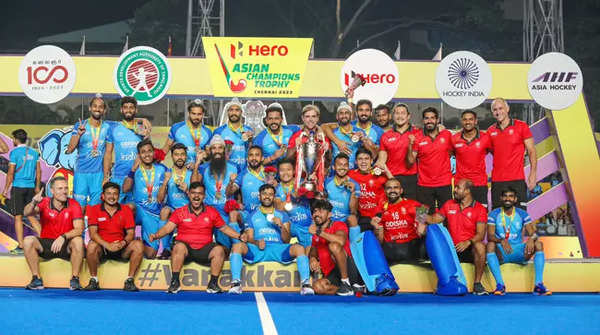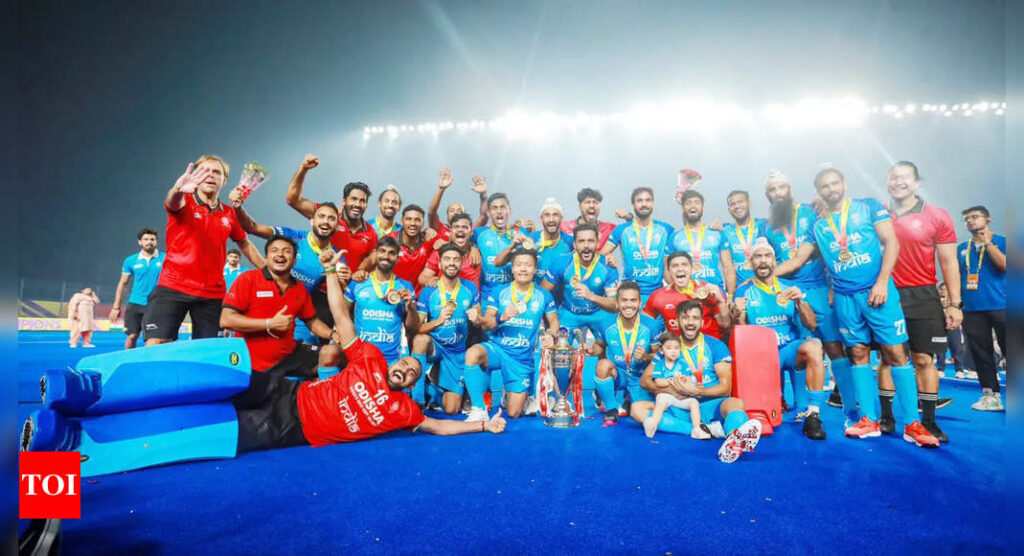[ad_1]
Sumit’s goal against Japan in the semifinal, easily the play and the goal of the Men’s Asian Champions Trophy 2023, and India’s sizzling comeback in the final to win the title explain the above, which is changing the narrative in Indian hockey.

10:09
‘Indian hockey has no competitors in Asia’ in conversation with Harendra Singh
Sumit had accelerated to overlap from the right-out position and receive the ball from Manpreet Singh. He was almost at the baseline when he decided to cut in and spotted the Japanese defence focused on marking other Indian attackers, while the goalkeeper was covering the near post. That’s when he smelled blood and flicked the ball off his reverse stick to deposit it between the bars.
A minus was the conventional option available but the fact that Sumit could scan the field in a microsecond and decide made the difference.
India were already up 3-0 when Sumit scored, which was almost the opposite to being 1-3 behind after 30 minutes in the final against Malaysia. That’s when they switched from coach Craig Fulton’s ‘defend to play’ Plan A and reverted to the traditional ‘full press’.
The fact that India could bring on the dynamic style after already spending 30 minutes on the field and then continued in the same fashion for the next 30 is where the stellar level of this team’s fitness comes to the fore.

Photo credit: Hockey India
The point in reference being that the Indian hockey players are now not just the fittest they had ever been, but are also working on developing the mental skills that enable them to make the right decisions in those key moments. Whether those decisions turn into a goal or a save is a different data and skill analysis, but the fact that a said player did what was tactically right is where the game is changing in India’s favour.

06:18
Committed to host international hockey throughout India: Dilip Tirkey
It highlighted in a passage of 30 seconds, when the pressure of Indian speed and their frequent attacks forced the Malaysians into mistakes, and once a chance to hurt arrived, India didn’t miss. Harmanpreet Singh, off a penalty stroke, and Gurjant Singh scored within seconds of each other to make it 3-3. It forced the Malaysians to sit back in defence, which is where they faltered and Akashdeep Singh scored in the 56th minute to complete a memorable turnaround.
THE NARRATIVE
Sitting 14,000 km away, former India coach Harendra Singh was glued to the action and had already predicted that India needed to be wary of the Malaysians on penalty corners (PC), especially the indirect ones.
They scored two of their three goals off PCs.
“The ‘defend to attack’ policy that Craig Fulton has introduced in this team, I fully support it because I always believe that offence wins matches and defence wins championships,” Harendra told TimesofIndia.com.
However, that plot was foiled by the Malaysians who chose to up the ante and were the more aggressive of the two teams in the opening exchanges.

04:10
Fighting India beat spirited Malaysia 4-3 to win ACT for fourth time
“India’s performance in the tournament, especially in the final, can be analysed on two grounds: first is fitness and the second is that we could bring and execute Plan B on the pitch when we needed it.”
The inference from that comment is that besides the focus being on structured defence, the team isn’t rote-memorizing anything and is willing to shift to a different plan when things aren’t working out, and has an extra gear that they can shift to.
But where India is quickly narrowing down the gap with the Europeans and the Australians is investment in fitness, which may not guarantee you wins but is a definite prerequisite if you want to win in modern hockey.
“When you are fit, your brain remains fully oxygenated and then you are able to make split-second decisions, which you cannot think of with a fatigued mind. When you are fatigued, your mind is prone to poor decision-making and it has cost us tournaments in the past. The 2010 and 2018 Asian Games semi-final defeats against Malaysia are prime examples of that,” Harendra further told TimesofIndia.com.
In both those games, India’s mistakes towards the end allowed Malaysia to come back, equalise, force a shootout, and win.
“Sometimes the senior players take the responsibility of fixing problems on themselves alone and not the entire team. That makes them put in an extra effort, get fatigued and commit mistakes, which penalizes the entire team,” said Harendra.
In the Asian continent particularly, none of India’s challengers have shown physical fitness that’s even close to what India have achieved, which interestingly also means that getting towards the end of a tournament, the players of other teams are relatively more fatigued compared to the Indian players. That can be a key differentiator between the champion team and the runners-up.
“Any team that plays us knows that we are really fit and they have to match us in all four quarters,” India coach Fulton said after the final.
“Your skill is derived from your level of fitness. So if you want to play a fast-paced game, you need to have that anaerobic speed, that sprint repeatability, you need it all, and I think we are growing in confidence that we can play at a high tempo,” he added.
The real impact of appointing a full-time psychologist in the form of Paddy Upton will require some more time to assess as the team is still getting used to this change.
“My 22 years of experience tells me that it can further confuse the players because they have to learn a new thing because it’s a long-term process. So I believe now that Upton has been brought on board, he should be there for a long term.”
THE GAME
The days of players waiting in their position to get the ball on stick are over. In modern hockey, the first skill is to run without the ball and get in a position to receive it on the run so that you have already cut down the distance and don’t need those extra few metres to accelerate in attack.
Like Harendra, Fulton too is a big advocate of off-the-ball play, which also plays a key role in switching flanks in play that India have adopted under the South African in order to gain mileage over the opponents, outnumber them and create more chances to score.
It’s something Fulton’s predecessor Graham Reid also used but not as a design to follow, which is the case now, along with the tactics of half-court press and withdrawn centre-forward on the lines of ‘defend to attack’ policy.
It’s always thrilling to see the entire Indian team running forward like a seawave during counter-attacks, which is what brought the Chennai crowd to the edge of their seats in the second half against Malaysia on Saturday. But under Fulton, it will remain a Plan ‘B’ as his tactics are not in favour of leaving the defence largely unattended and allow opponents to score on turnovers.
“Now we are preparing to compete with the Europeans and to do that you can’t give them space by always playing full press,” said Harendra. “This team is preparing itself on those lines, with the Paris Olympics as the target.”
Harendra said playing offence comes naturally to Indian strikers, but with the game evolving, India can’t risk being predictable all the time if they want to consistently finish on the podium.
“Every Indian player knows how to play in the offence, but it’s very important to make the players learn how to convert your defence-based structure into offence, which can now be seen in this team,” Harendra said.
The tournament’s highest scorer and India captain Harmanpreet remained at the top of his game, especially on drag-flicks; and the team’s depth in talent was highlighted in the final when India scored two field goals besides Jugraj’s penalty-corner strike on a day when their star skipper didn’t score off a PC.
“If you see other matches, the large percentage of goals were scored by Harman (on penalty corners). It also shows the depth in this team, which does not rely only on PCs and there are players with fire in the belly, who can score anytime. That is a very good sign,” observed Harendra.
It was important Fulton’s boys got a testing game like the ACT final before the Asian Games, where Harendra believes India’s only challenger will be India itself, especially with a midfield that’s the best India has ever had since the introduction of artificial surfaces.
“Can’t comment on the era of Ajit Pal Singh because I didn’t see him play; but since the age of astro-turf began in 1976, Hardik, Vivek, Nilakanta, Sumit and Manpreet form one of the best midfields I have seen (playing together).”
[ad_2]
Source link










More Stories
Australia exposed India’s little chinks in World Cup final: Sanjay Manjrekar | Cricket News
Rahul Dravid, BCCI engage in discussion but board inclined towards new coach | Cricket News
IPL 2024: Delhi Capitals retain Prithvi Shaw | Cricket News